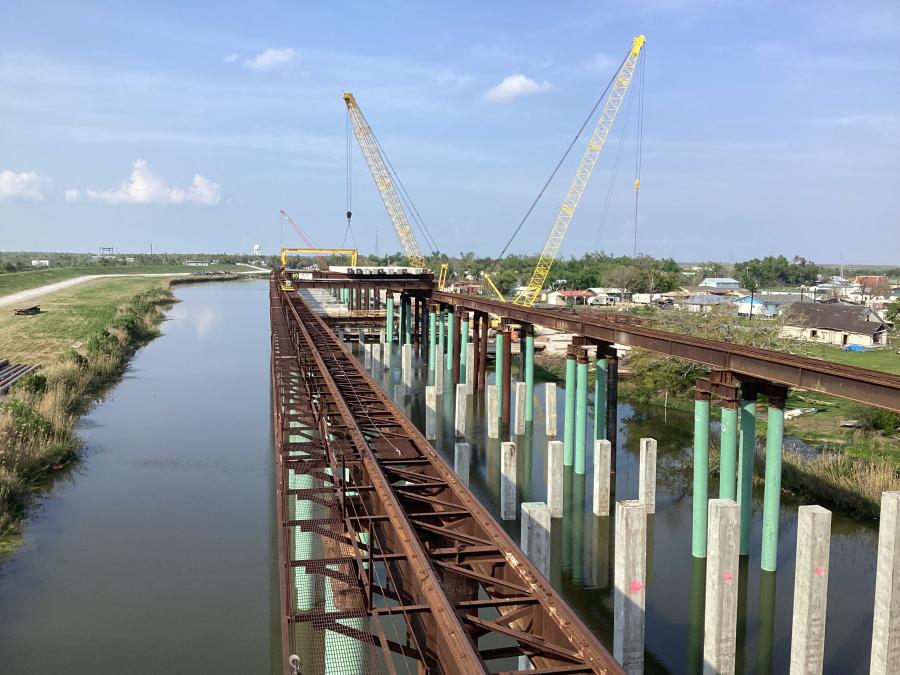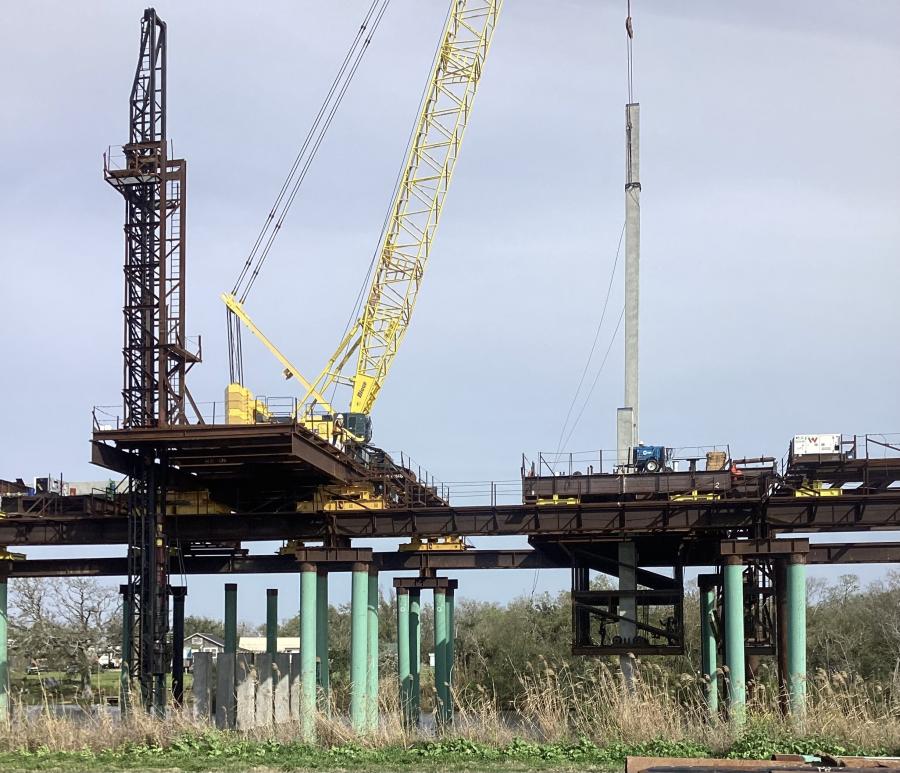View of pile looking north towards Hwy 3235.
(ECM Consultants photo)
Construction crews in southern Louisiana have begun phase two work on roughly 9 mi. of bridge that will connect Leeville to Golden Meadow in LaFourche Parish. Once this $464 million effort is complete, there will be 19.3 mi. of elevated expressway between Golden Meadow and Port Fourchon. The contract was awarded to Primoris Heavy Civil, James Construction Group LLC (JCG) of Baton Rouge.
"The project is important not just for the oil industry and economy, but also for the safety and wellbeing of residents and workers in the area," said
Daniel Gitlin, spokesman, New Orleans Area and Northshore Department of Transportation and Development (DOTD). "The LA 1 corridor is a critical link for the nation's oil energy sector, as LA 1 is the only roadway link from Port Fourchon LA, which is one of the largest energy ports in America.
"When the roadway is out of service it can cost America $550M of GDP. The roadway, in its current state, is low-lying and often susceptible to flooding from hurricanes and storm events in the Gulf of Mexico."
Gitlin noted that major undertakings such as the LA 1 project are generally broken down into phases to expedite work because finding funding for the entire project would be a tremendous task. The total cost could be estimated at upwards of $700 million. By breaking the projects into multiple phases, the money allocations can be spread out.
Phase two work began in early 2022, with an estimated completion date of late 2027. DOTD has selected ECM Consultants to help oversee the project.
"Motorists will be unaffected throughout construction, because this is a new roadway built adjacent to the existing one. There will be some phasing that requires traffic control when connections are made to the existing roadway system."
According to Gitlin, the strip of road will protect the area from flooding, particularly during storm seasons.
"The existing roadway is low-lying and often damaged or overtopped during storms. By replacing the roadway with a bridge deck near elevation 23 feet, we are significantly reducing or eliminating the likelihood that this route is overtopped in the future.
"The road could easily be overtopped by swells, sometimes well in advance of storm activity in the gulf, forcing workers to shut down operations in advance of a storm."
Gitlin added the work also is expected to help the local economy.
"Large projects such as LA 1 provide jobs to residents over a period of time. Significant spending is also done in areas surrounding commercial building efforts."
Ryan Morvant, Louisiana DOTD project manager, said the effort is hampered by personnel issues and supply-side delays.
"And as with most projects in Louisiana, weather is always a challenge. This close to the coast we can have violent thunderstorms with tropical force winds, and during hurricane season we must constantly keep an eye on the entire gulf.
"Louisiana has been hit by several hurricanes in the last four years. Regulations require us to demobilize and move our equipment to a safe place, then we must haul it back to pick up where we left off, but that could be a week or more as the state recovers."
Christopher Rogers, DOTD assistant district administrator/engineering, said working within the footprint of the finished structure is another obstacle for crews.
"As construction of the elevated structure moves forward through the coastal marsh on the trestle system, the finished structure behind it serves as the access road, laydown yard, storage area, etc. All construction activity is confined to the new roadway, which creates a tight work environment. The movement of equipment, materials, vehicles and machinery must be coordinated to ensure that various construction activities do not impede each other."
Working above the marsh and open water also requires the use of additional PPE, he said.
"Coastal southern Louisiana is a hot, humid place, and the extra layer of a life jacket all day on the job is a necessary burden that the workers must endure. The weather is also a concern, especially during the summer months. Besides tropical systems, thunderstorms can blow in daily from the Gulf of Mexico. Workers must be able to take cover quickly and safely since they are very exposed over the marsh on the structure."
The project, described as a long, uninterrupted bridge through the marsh, requires endurance and commitment.
"In that regard, it's important to have reliable machinery, as well as a reliable group of men and women to get the work done," said Gitlin. "A bridge is about connecting people, and until completion, it's just a road in the water. The satisfaction for everyone comes when the bridge is opened, and the job is complete."
Gary Gisclair, ECM Consultants Inc., senior construction engineer, said crews are driving concrete piles; pouring concrete caps; and pouring concrete decks. The work involves positioning a pile driving template, which is a metal framework that's fixed and situated where a series of concrete piles will be driven in place to support the bridge.
"Excavation is minimal on this project," Gisclair explained. "The only excavation that's required is when tying in the bridge concrete approach into the existing state highway on the northern end of the project. Most work on this project is concrete bridge building."
A total of 13,579 cu. yds. of excavation and 16,542 cu. yds. of embankment will be hauled in and placed during construction. Three large cranes and two lifting gantries are the main equipment being used on the job, where bridge building over the marsh area will be the most time-consuming part of construction. There will be up to seven cranes — ranging from 100 to 350 tons capacity — on the job at any given time.
According to JCG, the following additional materials will be used:
- 18-in., 24-in. and 30-in. concrete piles
- LG-36, LG-54, LG-63, LG-78 and steel plate girders
- 70,000 cu. yds. of Class A1 concrete
- 12,500 cu. yds. of Class A1 mass concrete
- 24,000,000 lbs. of reinforcing steel
- 5,800 cu. yds. of 10# riprap will be placed
- 10,500 cu. yds. of 55# riprap will be placed
"This project has a history dating back more than 20 years, so to see the work being done on what will be the final pieces is encouraging," said Gitlin. "Critical construction projects give residents and businesses security in knowing that the state has, and will continue to, support their needs and growth. Louisiana's waterways are a unique and critical part of the infrastructure of the United States. Having safe, reliable routes to and from lower coastlines are more important now than ever." CEG
Cindy Riley
Birmingham, Ala., native Cindy RIley originally planned on a career in law, but during her sophomore year in college realized journalism was her true calling. A magna cum laude graduate of Samford University, Riley first worked in radio and TV. Named Best News Anchor, Best News Reporter and Best Investigative Reporter by the Associated Press, she interviewed numerous personalities, ranging from Dr. Henry Kissinger and President Bush to Michael Jordan and Captain Kangaroo.
As a print journalist, Riley has covered a variety of topics, including construction, business, health and the arts. In addition to CEG, her work has appeared in special reports for USA Today and the L.A. Times. Other publications have included New South Magazine, Portico, Thicket, Alabama Heritage, B-Metro, Business First and Birmingham Business Journal.
Read more from Cindy Riley here.
Today's top stories



























